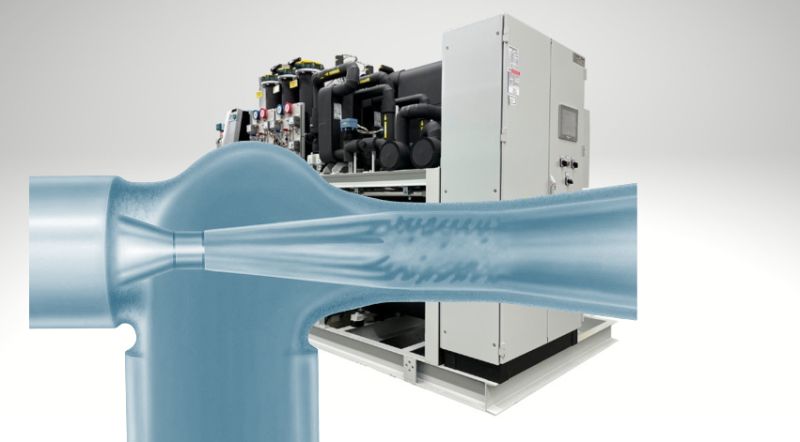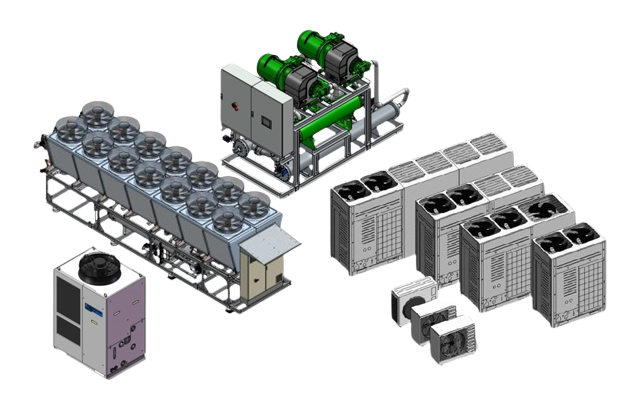|
More and more often, we are forced to plan several refrigeration systems or heat pumps in a relatively small area.
In most cases, the arrangement of the system is therefore planned on the basis of the available space. This one-sided focus can have drastic effects on the free air exchange of the systems, both for the supply air and the exhaust air of the systems. The architectural and atmospheric conditions around the systems can have a massive impact on their performance. Recessed roofs and walls, for example, can have a negative impact on the air flow due to turbulence. On the air outlet side, recirculation of the exhaust air can lead to a massive loss of system performance due to the higher air inlet temperatures during heat transfer. Another factor that is not often taken into account is the distance between the units, which not only influences the air flow, but can also lead to a massive recirculation of the exhaust air depending on the wind conditions. If the systems are installed one behind the other, the advantage is that the air flow remains free on all sides (Fig. 1). If the systems are arranged next to each other, it must be taken into account that, for example, with 3 systems, both sides of the air flow with the centre system are in the intake area of the two opposite systems (air shadow). Depending on the air volume of the systems, the distance between the systems must therefore be planned to be considerably greater than if they are installed one behind the other. (Fig. 2). The design of the systems is also a decisive factor in the arrangement of the systems. A particular example are systems in table-top design, often drycoolers whose condensers are usually installed a short distance from the floor (Fig. 3). If such units are installed too close to each other, the air flow of the supply air is negatively affected during simultaneous full-load operation, i.e. the inflow area is too small, which can lead to a reduction in performance of the units of up to 30%. One way of installing the units closer together is, for example, to elevate them on a grating to increase the air inflow area from below (Fig. 4). An additional advantage of elevation is the greater ground clearance which, depending on the nature of the substrate, e.g. soil or grass under the grille, also has a positive effect on the delta T between the supply air temperature and the cooling temperature, as soil heats up significantly less in direct sunlight than a concrete substrate, for example. In terms of sound, soil also has the advantage of absorbing sound and not reflecting it, as is the case with a sound-reflecting surface such as concrete.
1 Comment
Ejectors in heat pumps
Ejectors are innovative components that are used in heat pumps to significantly increase their efficiency. They enable a significant increase in efficiency by optimising and partially recovering the compression work required in the compressor. How ejectors work Ejectors work according to the Venturi principle. A high-pressure flow is accelerated through a nozzle, which leads to a drop in pressure. This pressure drop creates a vacuum, which makes it possible to attract a low-pressure flow (suction flow) that mixes with the high-pressure flow. The kinetic energy in the diffuser is then converted back into pressure energy, which leads to an increase in the pressure of the total mass flow. Advantages By recovering throttling losses, part of the compression work can be saved, which increases the overall energy efficiency of the heat pump Ejectors can significantly reduce the required power of the compressor or even replace a compressor stage in multi-stage systems. Ejectors allow adaptation to different operating conditions and can be used in different configurations to optimise performance. Challenges Despite their advantages, ejectors are not yet widely used in practice. Ejectors need to be precisely matched to their operating conditions, which places high demands on the design. Furthermore, uncertainty about the cost-benefit ratio is one reason why many manufacturers do not implement this technology. Overall, ejectors offer promising opportunities for increasing efficiency in heat pump systems, but require further research and development in order to optimise their application in industry and make them economically attractive. |
AuthorWe specialize in reducing noise emissions and increasing the performance of HVAC and industrial systems. Archives
January 2025
Categories |
We support you in solving noise problems - even at your premisesSilent Engineering
di Vicari Romolo Via Trento 22 IT-23875 OSNAGO (LC) www.forcotech.com [email protected] Phone: + 39 349 431 73 42 Contact Form VAT ID: 03833150133 Fiscal Code: VCRRML61E28Z133R Data Protection, Privacy, GDPR More Information ©Copyright (copyright notice) 2019/ 2020 / 2021 / 2022 / 2023 / 2024 - Silent Engineering - All contents of this website are subject to copyright. All content, in particular texts, images, logos, product names and graphics are protected by copyright. All rights, including reproduction, publication, editing and translation, require the express written authorisation of the website owner. This will only be granted after verification via PEC mail or registered letter. |
Our Brands around soundproofing |




 RSS Feed
RSS Feed




